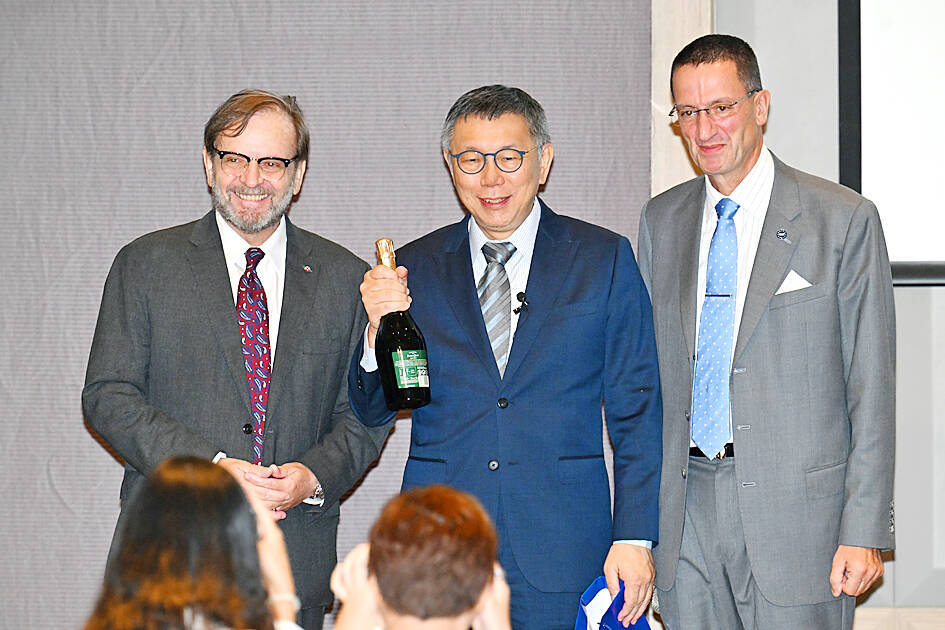The European Chamber of Commerce Taiwan (ECCT) yesterday invited presidential candidate Taiwan People’s Party (TPP) Chairman Ko Wen-je (柯文哲) for lunch to exchange views, as the foreign trade group found Taiwan lagging behind Japan and South Korea in public health expenditures.
Officials from Novartis AG, a Swiss multinational pharmaceutical company, said Taiwan spends less money on public health, compared with South Korea and Japan where people enjoy better healthcare resources and live longer.
They said that new approved drugs need a long time to hit the market and come under national health insurance coverage, denying patients better choices of medication and treatment.

Photo: Tien Yu-hua, Taipei Times
“Money used on health enhancement should be deemed as investment, instead of expenses,” they said, citing longer life expectancy and less medical need as returns and benefits.
Ko shared the observations, saying that public health spending constitutes only 6 percent of Taiwan’s GDP, much lower than South Korea’s 8 percent and Japan’s 11 percent.
Furthermore, it would take two years before approved new drugs can be bought on the market and is qualified for national health insurance coverage later, Ko added.
Ko said newly approved drugs should be put on the market right away, coming under health insurance coverage after clearing regulatory procedures online.
“Socialism should be upheld regarding public education and health regardless of economic models different countries embrace,” Ko said, adding that he would incrementally raise health expenditure to 8 percent a year if he steers the country.
The former Taipei mayor also proposed what he called a more pragmatic approach to ensure Taiwan’s energy supply stability by promoting “clean energy” to go hand-in-hand with “green energy.”
Ko said he supports the net-zero carbon emissions policy, but would adjust the power mix because heavy reliance on liquefied natural gas is unhealthy and unfeasible.
However, the TPP chairman said he would be flexible on wind farm regulations by allowing the market mechanism to settle disputes over the required technology localization.
“People in objection of the market mechanism should explain why and come up with alternative and practical solutions,” he said.
Ko added he would ease labor rules and allow more foreign workers into the nation, helping solve manpower shortages faced by assorted sectors on condition that they pay headcount taxes.

The US dollar was trading at NT$29.7 at 10am today on the Taipei Foreign Exchange, as the New Taiwan dollar gained NT$1.364 from the previous close last week. The NT dollar continued to rise today, after surging 3.07 percent on Friday. After opening at NT$30.91, the NT dollar gained more than NT$1 in just 15 minutes, briefly passing the NT$30 mark. Before the US Department of the Treasury's semi-annual currency report came out, expectations that the NT dollar would keep rising were already building. The NT dollar on Friday closed at NT$31.064, up by NT$0.953 — a 3.07 percent single-day gain. Today,

‘SHORT TERM’: The local currency would likely remain strong in the near term, driven by anticipated US trade pressure, capital inflows and expectations of a US Fed rate cut The US dollar is expected to fall below NT$30 in the near term, as traders anticipate increased pressure from Washington for Taiwan to allow the New Taiwan dollar to appreciate, Cathay United Bank (國泰世華銀行) chief economist Lin Chi-chao (林啟超) said. Following a sharp drop in the greenback against the NT dollar on Friday, Lin told the Central News Agency that the local currency is likely to remain strong in the short term, driven in part by market psychology surrounding anticipated US policy pressure. On Friday, the US dollar fell NT$0.953, or 3.07 percent, closing at NT$31.064 — its lowest level since Jan.

The New Taiwan dollar and Taiwanese stocks surged on signs that trade tensions between the world’s top two economies might start easing and as US tech earnings boosted the outlook of the nation’s semiconductor exports. The NT dollar strengthened as much as 3.8 percent versus the US dollar to 30.815, the biggest intraday gain since January 2011, closing at NT$31.064. The benchmark TAIEX jumped 2.73 percent to outperform the region’s equity gauges. Outlook for global trade improved after China said it is assessing possible trade talks with the US, providing a boost for the nation’s currency and shares. As the NT dollar

The Financial Supervisory Commission (FSC) yesterday met with some of the nation’s largest insurance companies as a skyrocketing New Taiwan dollar piles pressure on their hundreds of billions of dollars in US bond investments. The commission has asked some life insurance firms, among the biggest Asian holders of US debt, to discuss how the rapidly strengthening NT dollar has impacted their operations, people familiar with the matter said. The meeting took place as the NT dollar jumped as much as 5 percent yesterday, its biggest intraday gain in more than three decades. The local currency surged as exporters rushed to